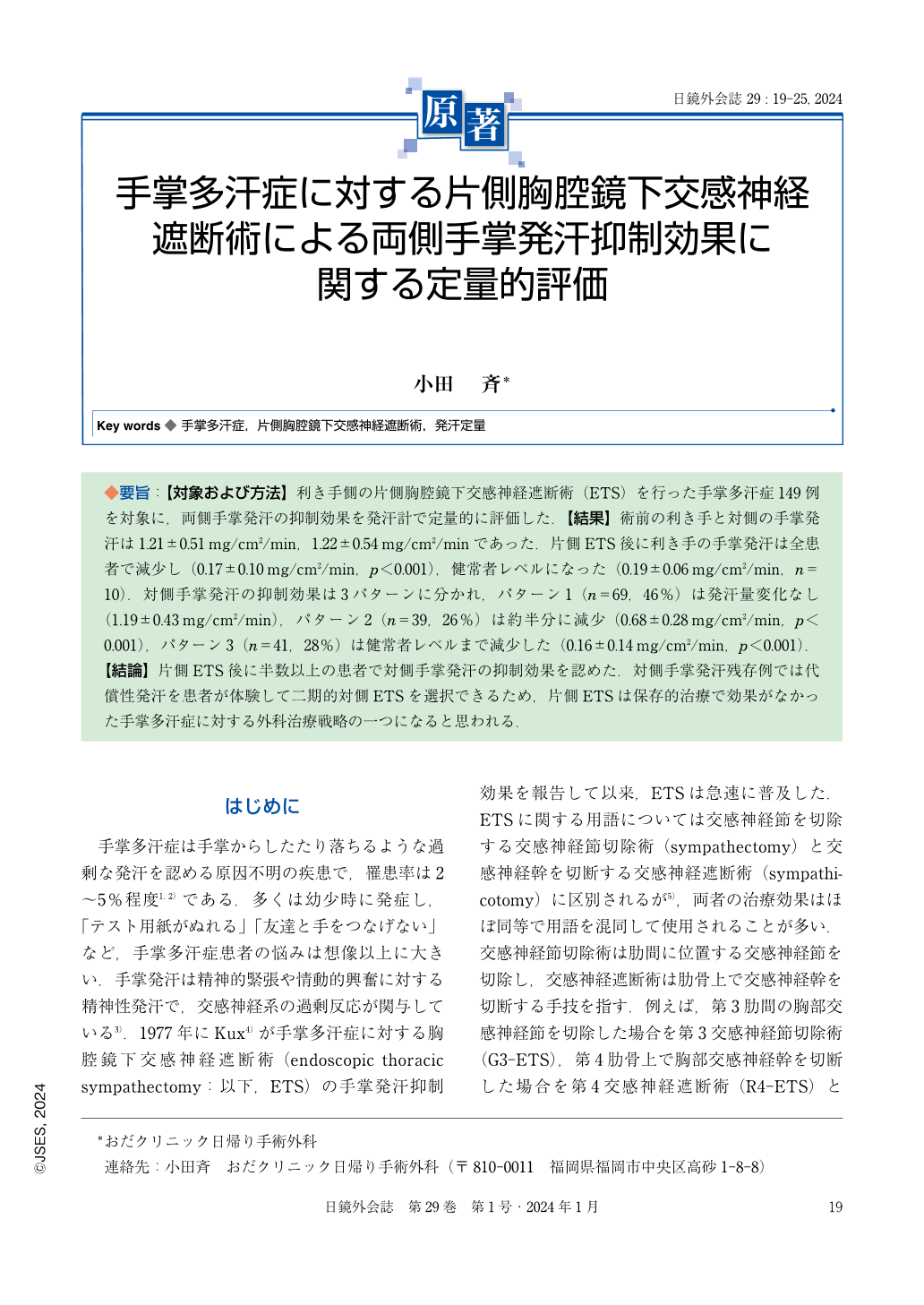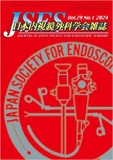Japanese
English
- 有料閲覧
- Abstract 文献概要
- 1ページ目 Look Inside
- 参考文献 Reference
◆要旨:【対象および方法】利き手側の片側胸腔鏡下交感神経遮断術(ETS)を行った手掌多汗症149例を対象に,両側手掌発汗の抑制効果を発汗計で定量的に評価した.【結果】術前の利き手と対側の手掌発汗は1.21±0.51mg/cm2/min,1.22±0.54mg/cm2/minであった.片側ETS後に利き手の手掌発汗は全患者で減少し(0.17±0.10mg/cm2/min,p<0.001),健常者レベルになった(0.19±0.06mg/cm2/min,n=10).対側手掌発汗の抑制効果は3パターンに分かれ,パターン1(n=69,46%)は発汗量変化なし(1.19±0.43mg/cm2/min),パターン2(n=39,26%)は約半分に減少(0.68±0.28mg/cm2/min,p<0.001),パターン3(n=41,28%)は健常者レベルまで減少した(0.16±0.14mg/cm2/min,p<0.001).【結論】片側ETS後に半数以上の患者で対側手掌発汗の抑制効果を認めた.対側手掌発汗残存例では代償性発汗を患者が体験して二期的対側ETSを選択できるため,片側ETSは保存的治療で効果がなかった手掌多汗症に対する外科治療戦略の一つになると思われる.
[Material and Methods]Bilateral palmar perspiration was quantitatively evaluated using a perspiration meter in 149 patients with palmar hyperhidrosis who underwent unilateral thoracoscopic sympathectomy(ETS)for the dominant hand.[Results]Before the operation, the amount of palmar perspiration of the dominant hand and that of the opposite hand were 1.21±0.51mg/cm2/min and 1.22±0.54mg/cm2/min, respectively. After unilateral ETS, palmar perspiration of the dominant hand decreased in all patients(0.17±0.10mg/cm2/min, p<0.001)to the level of healthy subjects(0.19±0.06mg/cm2/min, n=10), whereas the inhibitory effects on palmar perspiration of the opposite hand were divided into 3 patterns : pattern 1(n=69, 46%)had no change in perspiration(1.19±0.43mg/cm2/min), pattern 2(n=39, 26%)decreased by about half the amounts(0.68±0.28mg/cm2/min, p<0.001)and pattern 3(n=41, 28%)decreased to the level of healthy subjects(0.16±0.14mg/cm2/min, p<0.001).[Conclusion]After unilateral ETS for the dominant hand, more than half of the patients with palmar hyperhidrosis showed the inhibitory effect on palmar perspiration of the opposite hand. Patients with residual palmar perspiration of the opposite hand after unilateral ETS can experience compensatory sweating and determine the selection of secondary contralateral ETS. Therefore, unilateral ETS is considered to be one of the surgical strategies for the patients with palmar hyperhidrosis resistant to conservative treatments.

Copyright © 2024, JAPAN SOCIETY FOR ENDOSCOPIC SURGERY All rights reserved.


